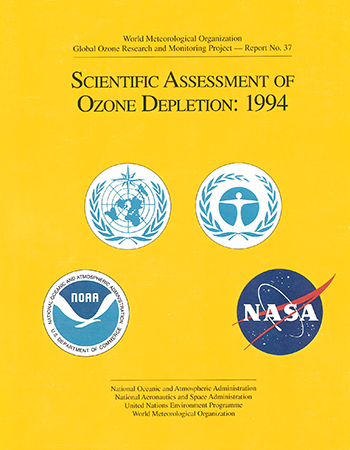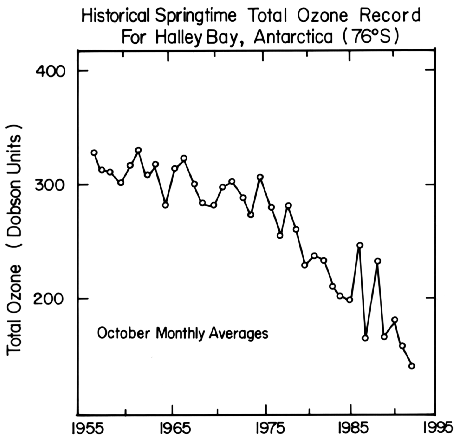Scientific Assessment of Ozone Depletion: 1994
Common Questions About Ozone

5. When Did the Antarctic Ozone Hole First Appear?
The Antarctic ozone hole is a new phenomenon. The figure shows that observed ozone over the British Antarctic Survey station at Halley Bay, Antarctica first revealed obvious decreases in the early 1980s compared to data obtained since 1957. The ozone hole is formed each year when there is a sharp decline (currently up to 60%) in the total ozone over most of Antarctica for a period of about two months during Southern Hemisphere spring (September and October). Observations from three other stations in Antarctica, also covering several decades, reveal similar progressive, recent decreases in springtime ozone. The ozone hole has been shown to result from destruction of stratospheric ozone by gases containing chlorine and bromine, whose sources are mainly human-made halocarbon gases.
Before the stratosphere was affected by human-made chlorine and bromine, the naturally occurring springtime ozone levels over Antarctica were about 30-40% lower than springtime ozone levels over the Arctic. This natural difference between Antarctic and Arctic conditions was first observed in the late 1950s by Dobson. It stems from the exceptionally cold temperatures and different winter wind patterns within the Antarctic stratosphere as compared to the Arctic. This is not at all the same phenomenon as the marked downward trend in total ozone in recent years referred to as the ozone hole and shown in the figure below.
Changes in stratospheric meteorology cannot explain the ozone hole. Measurements show that wintertime Antarctic stratospheric temperatures of past decades have not changed prior to the development of the hole each September. Ground, aircraft, and satellite measurements have provided, in contrast, clear evidence of the importance of the chemistry of chlorine and bromine originating from human-made compounds in depleting Antarctic ozone in recent years.
A single report of extremely low Antarctic winter ozone in one location in 1958 by an unproven technique has been shown to be completely inconsistent with the measurements depicted here and with all credible measurements of total ozone.
